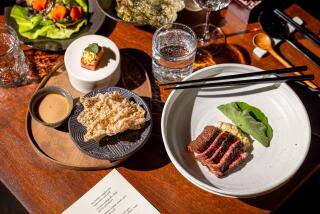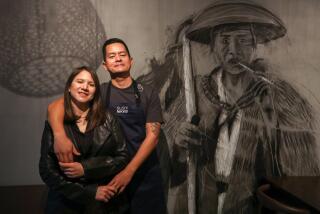Battle for Far East Market : U.S. Airlines Learn Finer Points of Service on Asian Routes
- Share via
Yukio Kato peered intently into the bowl of his food processor, making sure the texture of his finely chopped and seasoned boiled egg whites were just right. Satisfied, he set them aside and chopped up cooked egg yolks into a bright yellow fluff.
The Japanese chef then carefully lined the bottom of a pan with a half-inch layer of egg whites. Over that, he added a half-inch layer of the egg yolks. He carefully pressed the two together and refrigerated the appetizer.
Less than 24 hours later, passengers in business class of All Nippon Airways bound for Tokyo from Los Angeles would be savoring Kato’s nishiki tamago along with at least a dozen other painstakingly prepared and delicately presented Japanese foods.
The cuisine is hardly typical of meals served out of aircraft galleys, but fierce competition for loyal passengers among foreign and U.S. airlines flying across the Pacific is forcing improvements in food and service.
“It is the fastest growing air transport area in the world,” said Paul P. Karos, an analyst who follows the airline industry at First Boston Corp. in New York. “The reason for that is fairly simple: The Far East in general is one of the fastest growing economic regions in the world. Airlines are building off a smaller base so the growth is faster. It is in its early growth stages.”
Transpacific air traffic is expected to grow at an average annual rate of 11% through 1994, according to the International Civil Aviation Organization. In 1987, about 8.7 million passengers traveled between the United States and Asia--6 million between Japan and the United States.
Northwest, with a 24.9% market share, has a slight edge over United Airlines’ 23.8% but together the two U.S. carriers dominate the Pacific market, accounting for nearly half the available seats. Japan Air Lines is third with 18.2%, according to a report by Montgomery Securities. Other operators include Taiwan’s China Airlines, Cathay Pacific, Korea Air Lines and Singapore Airlines. Within the past two years, have come Delta, American and All Nippon Airways.
The American carriers may dominate the market, but the Asian carriers set the standard for food and service, and the U.S. airlines are struggling to match it. “There was absolutely no comparison,” said Ole Henriksen, who recently flew China Airlines to Taipei, but returned on United Airlines from Hong Kong. He flew first class both times.
He specially requested a vegetarian meal on both flights. On China Airlines, “everything was crisp and fresh,” he said. United served him canned asparagus and canned mushrooms. “When we arrived in Taipei, we felt like a million dollars,” Henriksen said. That wasn’t the case when he returned to Los Angeles. “I felt tired and hungry.”
United added a concierge service last year for its first-class passengers. Northwest is testing a number of changes to make its service “distinctive.” And American Airlines has changed the configuration of its business class seating on its Dallas-to-Tokyo flights to match the roomier accommodations offered by All Nippon.
Service becomes all important because the average transpacific flight takes 10 hours. In addition, it is the one area in which the airlines are concentrating their marketing efforts because they have little control over scheduling and fares--two other important factors to travelers.
Fares Relatively Stable
Schedules for departures to Asia are largely governed by arrival times designated by foreign governments. For example, at Tokyo’s Narita Airport, a major intermediate destination for flights continuing on to other Asian cities, flights from the United States converge within a four to five hour time span in the late afternoon.
Fares remain relatively stable because of international pricing regulation. Airlines, however, pay hefty commissions to ticket wholesalers in parts of Asia. They, in turn, have created a secondary market in heavily discounted, economy-class tickets.
But it is first-class and business passengers who are the most lucrative market for the airlines. “Business people don’t care about the price. What they individually care about are the food and service,” said Randi Tahara, director of the Pacific Rim affairs at the law firm of Jones, Day, Reavis & Pogue in Los Angeles. She says most of the firm’s attorneys prefer Asian carriers when business takes them overseas.
Wesley S. Kumagai, a Jones Day attorney on leave to work in Tokyo, has flown Singapore, Japan Air Lines and ANA. He says the Asian carriers make him feel pampered. “I never had the impression on these Pacific flights that any of the attendants had a whole lot else on their minds other than service, which is never true when I take a flight in the United States and certainly not in California. I don’t hear attendants talking about their schedules for the week or who they are going out with when they land.”
Providing service to transpacific air travelers takes attentiveness, sensitivity and increasing awareness of cultural differences.
“If you compare what’s going on today compared to five or 10 years ago, the biggest differences are the balance of market has decisively shifted to passengers originating out of the Orient,” explained A. B. (Sky) Magary, executive vice president, marketing, at Northwest Airlines. Today, he said, 60% of the passengers are Asian, 40% Americans. The majority of those Asian passengers are Japanese.
In the past, there was “a lot more emphasis on programs essentially geared to passengers out of the United States, who are very much in the minority though they are still important.”
“Little things are important to the Japanese. . . . You have to make them feel special. You have to judge (what they want) by the changes in their faces,” explained Masumi Shioda, a senior flight attendant for ANA. “American people are very joyful compared to the Japanese.” She said Americans always say “thank you” or make some other oral acknowledgment.
Reading the Japanese takes some practice. “Japanese passengers generally won’t ask you for anything,” said Betty Corbett, special supervisor, international, at Delta Air Lines in Atlanta.
“They want you to anticipate their needs. If they have sake , it is important we pour it for them and continue to do so. There is an old Japanese proverb that he who pours with one hand and drinks with the other, it is a bad omen. They won’t complain to you,” but they will tell their friends, added Corbett, who flew with Japan Air Lines as part of an in-flight exchange program when Delta was preparing for its Portland, Ore.-to-Tokyo service.
Americans are more forthcoming in their requests and complaints. “An American would say ‘I don’t like the movie’ or whatever,” Corbett said.
Koji Yamashita, ANA’s regional manager for the western United States, says: “Cabin attendant behavior and attitude is one of the most important things. Our basic motto is the human touch. American air carriers, generally speaking, are very functional and very practical. Particularly on a 10-hour flight, our cabin attendants avoid saying no. This small attitude makes a difference in the long range. They always open their eyes, always looking out for the passengers.”
Wanted More Champagne
It takes patience, though. On a recent ANA flight, an American traveling in first class said he loved strawberries. Shioda asked attendants--who are all female on ANA--to put together all the extra strawberries they could find to make a bowl--his second serving of fresh fruit.
Then he asked if there were four bottles of unopened champagne. Senior flight attendant Shioda had only two, and he asked for them. He also asked for a bag to put them in. She mentioned that his flight bag was probably in his carry-on bag and helped him look for it. She found that the bag was already filled with three unopened bottles of sake and fresh fruit.
“The passenger is always right,” explained Shioda.
U.S. carriers are tackling the nuances, too. United attendants no longer wear muu muus, loose, brightly patterned Hawaiian garments, on flights between Hawaii and Tokyo. Surveys indicated that business passengers felt uncomfortable with the informality, so United attendants now wear regular uniforms.
Asian passengers don’t like to be touched and are sensitive about hand gestures. “Anything handed to a passenger is done with two hands, whether it is a menu, blanket, pillow, magazine, anything,” said William C. Steicher, senior vice president, Pacific division of United.
United also completely redesigned its china, silver and crystal and redecorated its cabins in restful earth tones.
Delta hired special consultants to prepare videos for its flight attendants with tips on serving Asian passengers, including the proper placing of chopsticks on a food tray. For example, when a Japanese passenger puts his chopsticks horizontal across a dish that means he is finished.
Originally, Delta had planned to designate its Tokyo flight as No. 44, but changed it before service was initiated. Japanese consultants advised Delta that the number had connotations of bad luck to the Japanese, according to Frederick T. Hopmeier, director of international marketing.
Number Is Important
When Delta attendants serve food to first-class and business-class passengers, they avoid placing items in sets of four. “In Japan, the number four means death,” explained Corbett of Delta.
“If we serve carrots, we never give four, either three or five. We tend in the United States to give a lot of food to be hospitable. That is not relished by the Japanese. They would rather have artfully presented food on the plate rather than a large amount. They would rather have one spoonful of caviar beautifully placed with garnishes, rather than four spoonfuls.”
More to Read
Inside the business of entertainment
The Wide Shot brings you news, analysis and insights on everything from streaming wars to production — and what it all means for the future.
You may occasionally receive promotional content from the Los Angeles Times.










